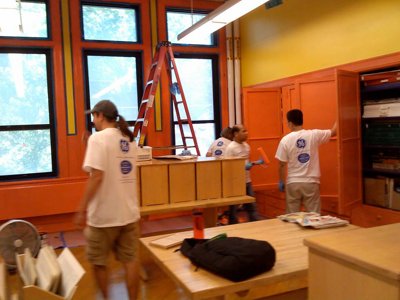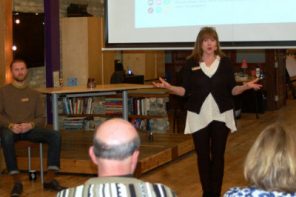When Kellie Krawcyzk found out the art program at her child’s school, Fernwood Montessori, would be completely eliminated in 2011, she was shocked. The art program had already been reduced to part-time in 2008, but the thought of her child not having art at all was unacceptable.
“There is indisputable evidence proving that students achieve higher levels of academic success when they have access to art,” says Krawcyzk.
“The arts, both visual and performing, are also essential in sustaining culture. We must give all students exposure to the arts, not just to nurture future artists, but to nurture creative, critical thinking in those pursuing all fields. Imagine if we had scientists or political leaders who lacked creativity.”
When Fernwood mom Beth Eaton Knepler heard about the budget cuts and the loss of the art program, she invited some parents over for coffee and to create a plan. Many of the parents had already volunteered at the school in some capacity.
“I had already taught after-school pottery classes, so I was comfortable with the art room and teaching,” says Knepler.
During the initial meeting, the group split up into teams of two and chose one age group to teach. The two team members then had a pool of other volunteers to draw from in case of conflicting schedules or illness.
They all committed to teaching three classes, one day a week.
“We thought we were committing to three hours of volunteering, but it always doubled or tripled,” says Knepler.
Most of the volunteer parents (comprised of all moms with the exception of one dad) were artists or worked in creative fields. The group got together a few weeks after the initial meeting with a series of projects and objectives.
The group later presented their plans to the principal, John Sanchez, who immediately supported the idea.
“We were off and running,” says Krawcyzk.
The parents / volunteer art teachers orchestrated projects that included large-scale mural painting, drawing, ceramics, paper weaving, collage, watercolor painting and more. They also has numerous fundraisers to offset the cost of supplies.
“The experience was incredible. The work was hard and at times exhausting but priceless in terms of the benefits to students,” says Krawcyzk. “There were visible transformations in most of the students as they gained self-confidence, built technical skills and developed creative thinking.”
Knepler, who is a professional ceramicist, says she loved every minute of the experience.
“I would do it every year if I had to,” says Knepler. “I still can’t believe it took 15 women to do a fraction of what one art teacher does.”
This year, Fernwood will have a new art teacher, Laura Makula-Zimmerman, who will also teach at Maryland Avenue Montessori.
“She has been hired back part-time with no art room. She will have to cart her supplies and instruct by traveling to each classroom,” says Krawcyzk.
Krawcyzk says the best part of filling in as a volunteer art teacher was the relationships she built with the students, especially those students who began as quiet or reluctant participants but transformed into enthusiastic participants as time went on.
“The relationships we formed with students were priceless. There was a clear understanding that we cared, not only for our own children, but for all the students. We are moms after all,” says Krawcyzk.
A group of moms took similar action when budget cuts reduced the art program three years ago at La Escuela Fratney in Riverwest. (Fratney will have a four-day-a-week art teacher this fall when former, popular art teacher Sue Pezanoski Browne returns to the school.)
“When the art teacher was cut and the kids weren’t going to have any creative outlet other than markers and paper at their desks, I asked another mom with some art background if she’d help with a clay project so the kids would have something to take home for the holiday season,” says Stacy La Point.
La Point, along with moms Jessica Laub and Tanya Otera and some of the Fratney teachers, volunteered their time so each class had enough time to make a clay project, fire it, glaze it and finish it in time to take home for the winter break.
La Point says they spent about $60 out-of-pocket on the project and took time off of work to complete it on time.
“Art is part of their quality of life at school. If they don’t have things to look forward to like art, music, gym, library and recess they get depressed, discouraged and resentful of school in general,” say La Point.


 i evaluate to yes even if there's no image
i evaluate to yes even if there's no image  i evaluate to yes even if there's no image
i evaluate to yes even if there's no image  i evaluate to yes even if there's no image
i evaluate to yes even if there's no image  i evaluate to yes even if there's no image
i evaluate to yes even if there's no image  i evaluate to yes even if there's no image
i evaluate to yes even if there's no image  i evaluate to yes even if there's no image
i evaluate to yes even if there's no image 